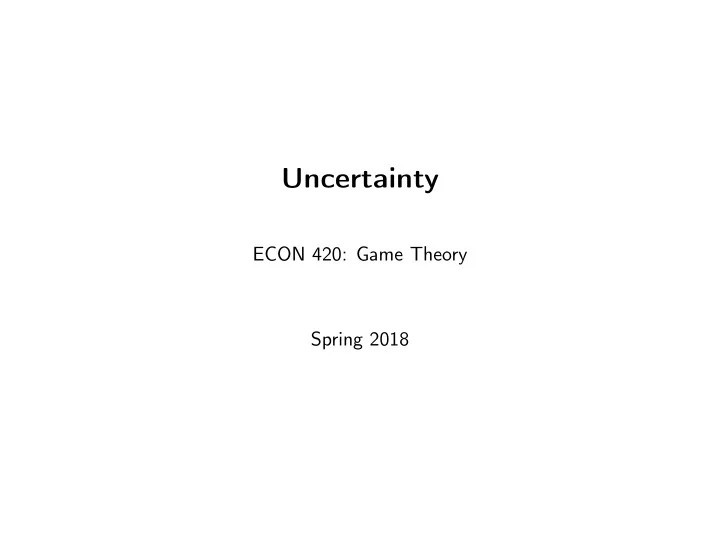

Uncertainty ECON 420: Game Theory Spring 2018
Announcements � Homework 3 on Canvas � Due Monday, May 21 � Reading: Chapter 8
Uncertainty � So far: Strategic uncertainty � Some players unaware of the actions of other players � Example: Simultaneous-move games � Today: External uncertainty � "Nature" changes aspects of the game � Players cannot control external uncertainty, must take it into account when making decisions
Expected Utility Theory � Events that happen according to some probability distribution are called gambles � Agents are able to rank gambles by comparing the expected utility that they would receive from the potential outcomes of the gamble � The utility that we will use is von Neumann-Morgenstern (VNM) utility
Risk preference � When there is uncertainty we can calculate the expected value of a gamble � But people do not just consider expected value when making decisions � Some people might be willing to pay to avoid risk (risk aversion)
Example � Suppose I fl ip a coin. If heads, you get $100. If tails, you get $0. � What is the expected value? � How much would you pay to play this game? � Suppose instead the payo ff s are $1 million for heads, $0 for tails.
VNM Utility and Risk Preference � Outcomes are denoted D (dollars) � Agents in the model have preferences over outcomes represented by utility u = u ( D ) � The risk preference of the agent depends on the concavity of the utility function u � Agents with diminishing marginal utility are risk averse � Concave utility function
Risk aversion
Risk seeking
Example � A farmer’s crop yield depends on weather � Farmer gets good weather with 50% � Yield with good weather is $160,000, yield in bad weather is $40,000 � Farmer has VNM utility u ( D ) = √ D
Risk sharing � Risk averse agents willing to pay to remove risk � Agents can therefore bene fi t from trading state-contingent claims with one another � You agree to pay someone else if you have a good outcome, someone else pays you if you have a bad outcome
Example � Suppose there is another farmer that has the same weather probability and outcomes (weather probability is independent of fi rst farmer) � Farmers agree to a contract: If one farmer gets good luck and the other gets bad luck, lucky farmer pays $60,000 to the unlucky farmer � Are the farmers better o ff ?
Example � Now suppose the other farmer faces no uncertainty and will earn $100,000 with probability 1 � The farmer with risk is willing to accept their certainty equivalence instead of the gamble � Is the riskless farmer willing to buy the risk in exchange for the certainty equivalence?
Example � Now suppose the farmer without risk is risk neutral � What is the maximum that this farmer is willing to pay for the gamble?
Insurance and risk � Suppose there are thousands of farmers with identical risk/outcomes � A single entity (insurance company) can buy the risk of all of the farmers and make them better o ff � Law of large numbers says that the insurance company will earn the expected value of the gamble
Manipulating Risk � Sometimes agents have control over risk and can use it to their advantage � By increasing risk, the probability of "tail events" increases � This is why underdogs in sports often choose risky actions
Example � A basketball team scores 60 points per game on average � They are playing a better opponent and must score at least 80 points to win � How can this team maximize their chances of winning?
Cheap Talk � In coordination games, players may be able to costlessly communicate before the game begins � This might allow players to better coordinate on preferred outcomes
Recommend
More recommend